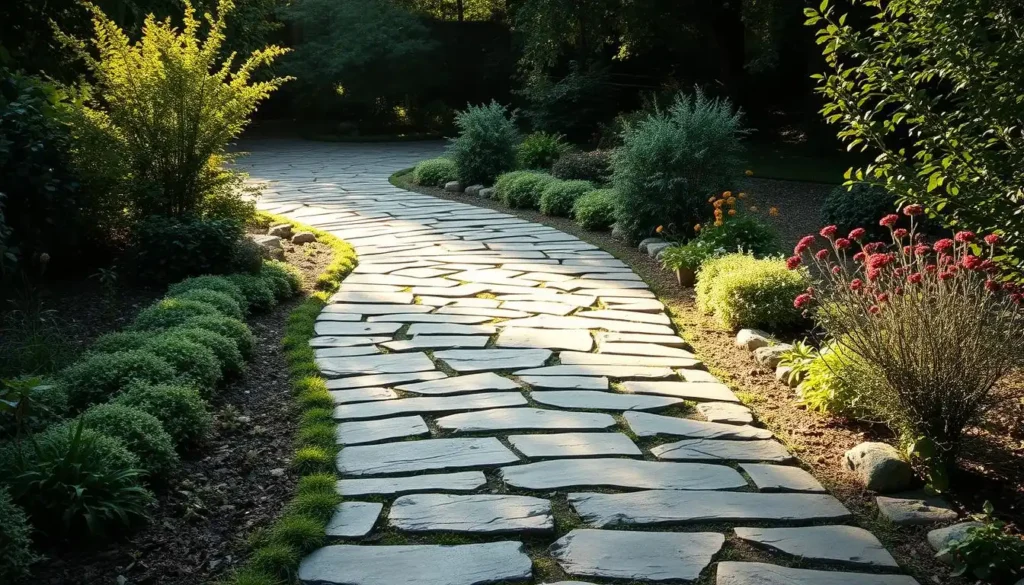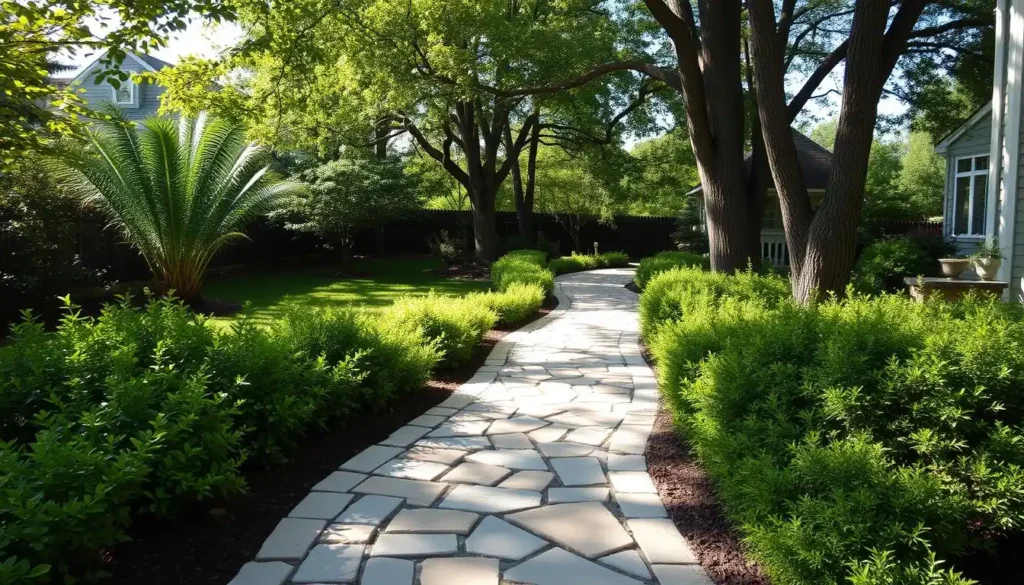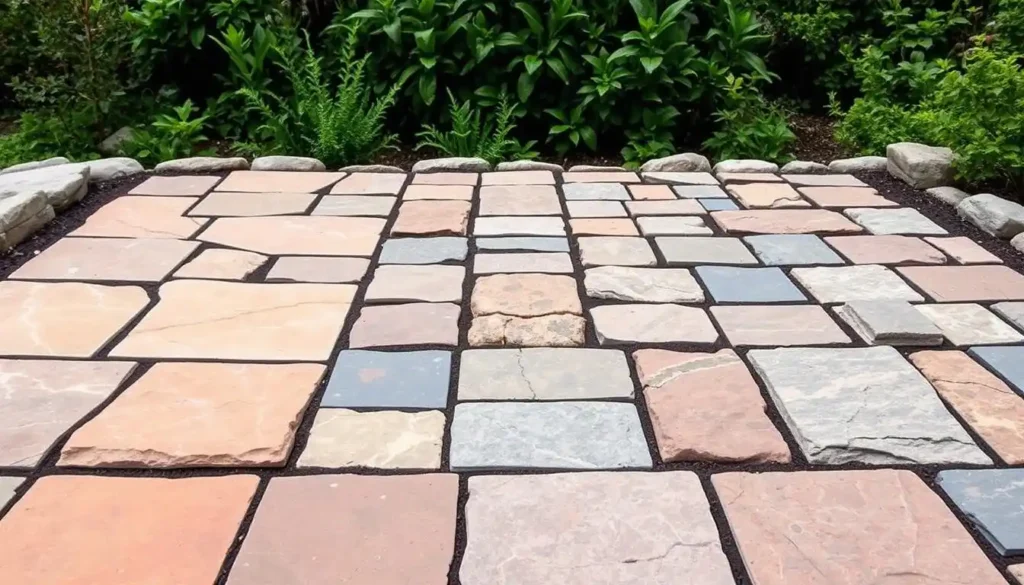Turning your outdoor area into a stunning backyard is simpler than you might think. One great way to do this is by adding a well-designed flagstone path. It not only looks good but also makes your space more inviting and useful.
A beautifully made flagstone path can take your garden to the next level. It guides visitors through your garden, bringing peace and calm. By picking the right materials and design, you can make a unique outdoor area that shows off your style.
Key Takeaways
- Flagstone paths can greatly improve your backyard’s look.
- A well-designed path can make your outdoor space more functional.
- Choosing the right materials is key for a beautiful and lasting flagstone path.
- Proper installation is crucial for a successful flagstone path project.
- A flagstone path can boost your home’s value and curb appeal.
The Timeless Appeal of Flagstone Paths
Flagstone paths have been a favorite in outdoor design for centuries. They bring a timeless charm that fits many landscape styles. Adding these natural stone pathways can greatly improve your backyard’s look.
Natural Beauty and Durability
Flagstone paths are loved for their natural beauty and durability. This type of rock can handle all kinds of weather, making it perfect for outdoors. Its natural look and earthy colors warm up your outdoor area, making it feel welcoming.

Complementing Various Landscape Styles
Flagstone paths work well with many landscape styles, from rustic to modern. You can pick the right flagstone to fit your backyard’s look, creating a unified feel. Whether you want a peaceful garden path or a practical walkway, flagstone is a great choice.
| Landscape Style | Flagstone Characteristics |
|---|---|
| Rustic | Earthy tones, irregular shapes |
| Modern | Clean lines, uniform colors |
| Traditional | Classic patterns, natural textures |
Understanding the timeless charm of flagstone paths helps you make smart choices for your outdoor design. It can enhance your backyard’s beauty and usefulness.
Planning Your Perfect Flagstone Path
To make a stunning flagstone path, you must plan carefully. Think about several important factors that will shape your path’s look and feel.
Determining the Path’s Purpose and Location
First, decide what your path will be for. Will it be a main route through your garden or a path to a special spot? This choice will guide where and how your path will go.
Choosing the Right Path Width and Layout
The path’s width and design are key for both looks and use. A wider path is better for more people, while a narrower one can feel cozy. Think about how your path will fit with your garden’s layout.
Creating a Design Plan
After figuring out your path’s purpose, location, width, and design, make a detailed plan. Choose the flagstone pattern, stone type, and how it will blend with your garden.
| Path Width | Suitable for |
|---|---|
| 3-4 feet | Main pathways, wheelchair accessible |
| 2-3 feet | Secondary paths, intimate areas |

By following these steps, you can make a flagstone path that beautifies your outdoor area and is also practical. Knowing how to lay flagstone well is essential for a great result.
Types of Flagstone for Different Backyard Styles
Homeowners can make their outdoor spaces unique with the variety of flagstone. Each type of stone has its own look and feel. This lets you pick the perfect flagstone for your landscape design.
Sandstone: The Popular Choice
Sandstone is a favorite for flagstone paths because of its warm colors and strength. It comes in many colors, from light beiges to deep reds. Its texture and color make any landscape more beautiful.
Limestone and Slate Options
Limestone and slate are great alternatives for flagstone paths. Limestone has a light color and soft texture. Slate, on the other hand, has a darker look. Limestone makes spaces feel bright, while slate adds elegance.
Regional Stone Varieties
Local stones can give your path a special charm. For example, Pennsylvania bluestone is known for its strength and blue-gray color. Other places have their own unique stones, like Arizona flagstone or Texas sandstone.

| Flagstone Type | Color Range | Durability |
|---|---|---|
| Sandstone | Beige to Red | High |
| Limestone | Light Gray to Beige | Medium |
| Slate | Dark Gray to Black | High |
Knowing about the different flagstones helps you choose the right one for your path. It ensures your backyard looks great and lasts long.
Budgeting for Your Flagstone Path Project
Planning your budget for a flagstone path is key to avoiding financial stress. A good budget helps you keep costs in check. This way, your project stays within your financial means.
Cost Factors: Materials, Labor, and Tools
The cost of your flagstone path project depends on materials, labor, and tools. Materials include flagstone, sand, gravel, and edging. Labor costs vary based on whether you do it yourself or hire pros. Tools like trowels and levels also add to the cost.
| Cost Factor | Estimated Cost |
|---|---|
| Materials (Flagstone, Sand, Gravel) | $500-$1,500 |
| Labor (DIY or Professional) | $0 (DIY) or $1,000-$3,000 (Professional) |
| Tools | $100-$500 |
DIY vs. Professional Installation
Choosing DIY or hiring pros impacts your budget a lot. DIY saves on labor but takes your time. Pros ensure quality but cost more.
Ways to Save Without Sacrificing Quality
To save money without losing quality, try these tips:
- Look for the best prices on materials.
- Choose a simpler design to save on cutting costs.
- Use local materials to cut down on transport costs.
Understanding costs and using smart saving tips can help you create a stunning flagstone paver walkway within your budget. When planning to lay flagstone, keep these tips in mind for a successful project.
Essential Tools and Materials for Installing Flagstone
Starting a flagstone installation project? You’ll need the right tools and materials for success. A durable and beautiful flagstone path requires careful stone selection and base preparation.
Stone Selection and Quantity Calculation
Choosing the right flagstone is key. Think about color, texture, and size to match your landscape. Measure the area for installation, considering the pattern and spacing.
| Stone Type | Characteristics | Quantity Needed |
|---|---|---|
| Sandstone | Popular for its warm tones and durability | Based on area measurement |
| Limestone | Offers a classic, elegant appearance | Based on area measurement |
| Slate | Known for its dark colors and fine texture | Based on area measurement |
Base Materials and Tools
A solid base is crucial for flagstone installation. You’ll need sand, gravel, and a compactor. A level, trowel, and edging tools will help you finish professionally.
Safety Equipment
With the right materials and tools, you’re ready to start your flagstone path project confidently.
Preparing the Ground for Your Flagstone Path
The life and look of your flagstone path start with good ground prep. This step is key to keeping your path strong and beautiful for years.
Ground prep has a few important steps. First, you must mark the path area right.
Marking the Path Area
To mark the path, use a hose or rope to draw its edges. Then, stakes and twine can make the lines clearer. This helps you see the path’s shape and make changes if needed.
Excavation Techniques
After marking, it’s time to dig. Dig about 4-6 inches deep, depending on your flagstone and base. Use a shovel or fork to remove soil carefully, without harming the area around.
Creating Proper Drainage
Good drainage stops water buildup and erosion. You can slope the path or add a French drain. Make sure the base material is packed tight for a solid path base.
By doing these steps, you’ll make a strong base for your flagstone path. This ensures it lasts long and stays stable.
How to Lay Flagstone: Step-by-Step Process
To install a flagstone walkway, follow a series of steps. This ensures a stable and visually appealing result. It involves careful planning, preparation, and execution.
Installing the Base Layer
The first step is to prepare the base layer. Excavate the area to a depth of 4-6 inches. This depends on the thickness of your flagstone and the base material. Lay down a layer of compacted gravel or sand for a stable base.
Base Layer Materials: Use a mix of gravel and sand for good drainage and stability.
Arranging Flagstones for Optimal Fit
After preparing the base layer, start arranging your flagstones. Lay out the stones without sand or gravel to plan the pattern. You might need to cut or shape stones to fit around curves or obstacles.
Tip: Leave about 1/4 to 1/2 inch between stones for sand filling.
| Step | Description | Materials Needed |
|---|---|---|
| 1 | Excavate the area | Shovel, Wheelbarrow |
| 2 | Lay the base layer | Gravel, Sand, Compactor |
| 3 | Arrange flagstones | Flagstones, Hammer, Chisel |
Cutting and Shaping Techniques
To fit flagstones around curves or obstacles, you’ll need to cut or shape them. Use a hammer and chisel for this. Score the stone where you want it to break, then strike it firmly.
Safety Tip: Always wear protective gear, including gloves and safety glasses, when cutting stone.
By following these steps and paying attention to detail, you can create a beautiful and durable flagstone path. It will enhance your outdoor space.
Creating an Accessible Flagstone Paver Walkway
An accessible flagstone walkway makes your yard look better and ensures safety for everyone. When designing your walkway, think about features that make it easy for all to use.
ADA Compliance Considerations
The Americans with Disabilities Act (ADA) has rules for accessible paths. For a flagstone walkway, this means a smooth surface and stable ground. The path should not have sudden changes in height and must be firm.
Ensuring Proper Width and Stability
A flagstone path should be at least 36 inches wide for easy walking. Use a strong base and proper installation to keep it stable. Regular upkeep is key to avoid tripping hazards.
Managing Slopes and Transitions
It’s important to handle slopes and transitions carefully when building a flagstone walkway. The path should have a gentle slope to avoid water buildup and ensure easy access. Transitions between different surfaces should be smooth to prevent tripping.
By following these guidelines, you can make a beautiful and accessible flagstone paver walkway. It will enhance your outdoor space and provide a safe, enjoyable experience for everyone.
Enhancing Your Flagstone Path with Lighting and Borders
To make your flagstone path even better, think about adding lighting and borders. These features can boost safety, ambiance, and beauty in your outdoor area.
Lighting Options for Safety and Ambiance
Good lighting makes your path safe and welcoming. Look into solar-powered lights for green energy or LED fixtures for saving power. Place lights along the path, under stones, or around other features for a cozy glow.
Creating Defined Edges and Borders
Clear edges on your path look better and stop weeds. Use plastic or metal edging for a sharp border. These materials last long and handle weather well.
Incorporating Water Features and Plantings
Adding water features and plants makes your path more interesting. Think about a small pond or fountain or flowers and shrubs along the path. This boosts its beauty.
With these additions, you can enjoy your path day and night. It becomes a stunning outdoor space that shows off your style.
Conclusion: Enjoying Your Beautiful Flagstone Pathway
Now that you know how to make a stunning flagstone path, it’s time to make your backyard dream come true. A well-made flagstone path can make your outdoor area more welcoming and useful. By following the steps in this article, you can create a beautiful and lasting flagstone path that fits your landscape.
When planning your flagstone path, think about its purpose, layout, and budget. With the right materials and tools, you can get a professional look. Whether you want a winding path or a straight one, a flagstone path adds beauty to your backyard.
Adding a flagstone path to your landscape design improves your outdoor space’s look and makes it safer for everyone. So, start planning your flagstone path project today. Get ready to enjoy your beautiful outdoor oasis for many years.
FAQ
What is the best way to lay flagstone for a walkway?
To lay flagstone, first prepare the ground. Then, add a base layer of sand or gravel. Finally, arrange the flagstones for a level and stable surface.
How do I choose the right type of flagstone for my backyard?
When picking flagstone, think about color, texture, and durability. Choose a type that fits your landscape design, like sandstone, limestone, or slate.
What are the benefits of using flagstone for a patio or walkway?
Flagstone is great for patios and walkways. It’s beautiful, durable, and easy to maintain. It’s perfect for outdoor spaces.
How do I ensure proper drainage for my flagstone path?
To drain properly, slope your path slightly. You might also need a French drain or other solution to avoid water buildup.
Can I install flagstone myself, or do I need to hire a professional?
Installing flagstone yourself is possible. But, a professional can do a better job, especially for big or complex projects.
How do I maintain my flagstone path to prevent damage and wear?
Keep your path clean and seal it when needed. Check for damage or wear and fix it quickly to avoid more problems.
What is the best way to cut and shape flagstone for my project?
To cut flagstone, use a wet saw or chisel and hammer. Always wear protective gear and follow safety rules.
How do I create a stable base for my flagstone path?
To make a stable base, dig the area first. Then, lay down compacted gravel and add sand. This ensures a level and stable surface.

